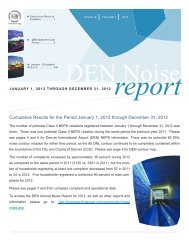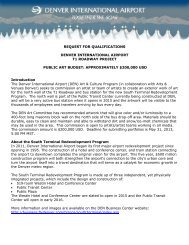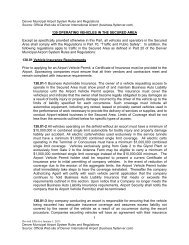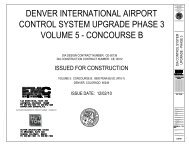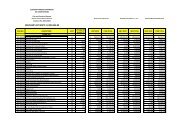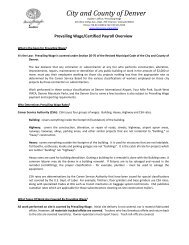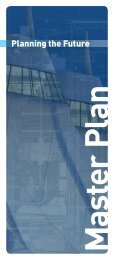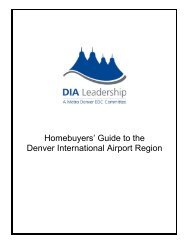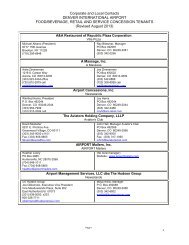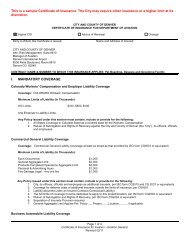PKF Hotel Market Demand and Financial Analysis - DIA Business ...
PKF Hotel Market Demand and Financial Analysis - DIA Business ...
PKF Hotel Market Demand and Financial Analysis - DIA Business ...
You also want an ePaper? Increase the reach of your titles
YUMPU automatically turns print PDFs into web optimized ePapers that Google loves.
The Westin Denver International Airport<strong>Hotel</strong> <strong>Market</strong> <strong>Analysis</strong>1. Historical Performance of the In-Terminal <strong>Hotel</strong>sPresented in the following table is the historical performance of the in-terminallodging market from 2007 through 2011, as well as YTD June 2011 <strong>and</strong> 2012.The Westin Denver International AirportHistorical Performance of the Competitive <strong>Market</strong>Annual Percent Occupied Percent <strong>Market</strong> Percent PercentYear Supply Change Rooms Change Occupancy ADR Change RevPAR Change2007 1,941,435 - 1,556,749 - 80.2% $164.46 - $131.87 -2008 1,941,435 0.0% 1,476,369 -5.2% 76.0% $160.58 -2.4% $122.11 -7.4%2009 1,941,435 0.0% 1,401,656 -5.1% 72.2% $140.74 -12.4% $101.61 -16.8%2010 1,941,435 0.0% 1,517,808 8.3% 78.2% $140.08 -0.5% $109.51 7.8%2011 1,941,435 0.0% 1,542,975 1.7% 79.5% $146.67 4.7% $116.57 6.4%CAGR 0.0% - -0.2% - - -2.8% - -3.0% -YTD Jun '11 970,718 - 784,654 - 80.8% $148.43 - $119.98 -YTD Jun '12 970,718 0.0% 791,873 0.9% 81.6% $150.62 1.5% $122.87 2.4%Source: <strong>PKF</strong> Consulting USA<strong>Dem<strong>and</strong></strong> at the in-terminal hotels decreased at a CAGR of 0.2 percent over the pastfive years with occupancy ranging from a low of 72.2 percent in 2009 to a high of80.2 percent in 2007. Similar to the performance of most lodging markets acrossthe U.S., dem<strong>and</strong> declined in 2008 <strong>and</strong> 2009 as a result of the economic downturn.The in-terminal hotels experienced a decline of 5.2 <strong>and</strong> 5.1 percent in 2008 <strong>and</strong>2009, respectively. As the economy began to improve <strong>and</strong> air travel returned toprior year levels, dem<strong>and</strong> at the in-terminal hotels increased 8.3 percent in 2010,resulting in an occupancy level of 78.2 percent. <strong>Dem<strong>and</strong></strong> further increased 1.7percent in 2011, resulting in an occupancy level of nearly 80 percent. Occupancyfor the in-terminal hotels remained flat over prior year levels at approximately 81percent through YTD June 2012. It is worth noting that an overall occupancy ofapproximately 80 percent represents the maximum level of performance for thissample of hotels given market segmentation <strong>and</strong> dem<strong>and</strong> seasonality <strong>and</strong> explainsthe flat five-year CAGR in dem<strong>and</strong> <strong>and</strong> minimal YTD dem<strong>and</strong> growth.It is also worth noting that over the five year historical period, the occupancy for thein-terminal hotels has averaged 77.2 percent <strong>and</strong> that the average size of the 12hotels is 443 rooms. When reviewing the local <strong>DIA</strong> competitive airport hotels, thefive year occupancy average was lower at 74 percent <strong>and</strong> yet the average hotel sizewas much smaller at 198 rooms. This indicates that there is a clear competitiveadvantage, which translates into an occupancy performance premium, for interminalhotels when compared to their respective competitors that are notphysically attached to the airport.ADR for the in-terminal hotels decreased at a CAGR of 2.8 percent between 2007<strong>and</strong> 2011. While the aggregate ADR was in the low to mid-$160 range in 2007 <strong>and</strong>IV-36



